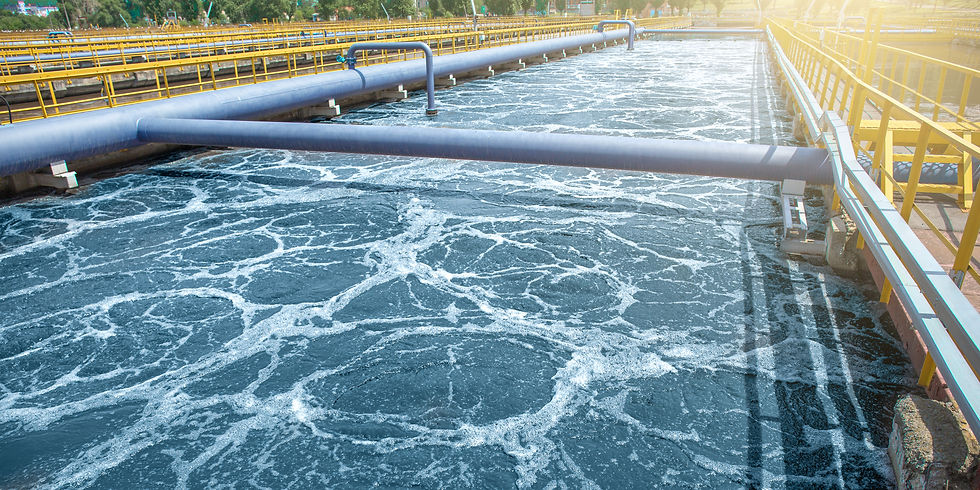Tackling the Slime: Overcoming Challenges in Wastewater Recycling with Innovation
- Jeff Yu
- Aug 29, 2025
- 4 min read
Updated: Oct 15, 2025
The Biofouling Challenge in Wastewater Recycling: Solve RO Membrane Slime with Rotek® KF-220

Wastewater recycling is no longer a futuristic concept but a present-day necessity.
As freshwater resources become increasingly scarce, effectively treating and reusing wastewater is crucial for sustainability across industries and municipalities. However, the journey of water from "waste" to "reusable" is fraught with challenges, one of the most persistent being the battle against an invisible enemy: microbial growth and the resulting biofouling.
The Persistent Problem: Biofouling in Water Treatment Systems
At the heart of many advanced water treatment systems, particularly those employing Reverse Osmosis (RO) technology, lies a delicate membrane. These RO membranes are designed to filter out even the smallest impurities, producing high-quality water. However, they are highly susceptible to a phenomenon known as Biofouling. Biofouling is the undesirable accumulation of microorganisms, such as bacteria, algae, fungi, and diatoms, along with their secreted extracellular polymeric substances (EPS), forming a slimy layer – commonly known as biofilm or simply "slime." This slime can wreak havoc on wastewater recycling efforts:
Clogging and Reduced Flow: Biofilm physically obstructs the pores of RO membranes, leading to a significant decrease in the flow of treated water (permeate).
Decreased Water Quality: The biofilm itself can release contaminants or allow certain particles to pass through, compromising the quality of the recycled water.
Membrane Damage: Prolonged biofouling can cause irreversible damage to the sensitive RO membranes, necessitating costly replacements.
Increased Operational Costs: To combat biofouling, plants often face:
Frequent Cleaning Cycles: Requiring plant shutdowns and the use of harsh chemical cleaners.
Higher Energy Consumption: More pressure is needed to push water through clogged membranes.
Frequent Replacement of Pre-filters: Such as cartridge filters, which become clogged more rapidly.
Downtime: The need to stop operations for cleaning or maintenance disrupts the continuous supply of recycled water.
Traditionally, controlling slime on RO membranes involved stopping the plant and soaking the membranes in disinfection chemicals. While somewhat effective, this approach means operational downtime and the use of potentially harsh biocides that can have their own set of environmental and safety concerns, and sometimes even negatively affect the membranes themselves.
A New Wave in Slime Control: Rotek® KF-220

What if there was a way to manage slime without halting operations and with a gentler, yet powerful, approach? This is where Rotek® KF-220 steps in as a game-changing solution.
Rotek® KF-220 is not just another disinfectant. It's a revolutionary online slime control agent. Its unique mechanism focuses on peeling off the existing slime from RO membranes and preventing its reformation, all while the plant continues to operate.
How is Rotek® KF-220 Different?
Continuous Online Treatment: The most significant advantage is its ability to be dosed directly into the system during operation. This eliminates the need for costly shutdowns, ensuring a continuous and stable supply of treated water.
Gentle Yet Effective Mechanism: Unlike conventional biocides that aim to kill microbes (which can sometimes leave behind cellular debris contributing to fouling), KF-220 works by disrupting the biofilm's adhesion to surfaces. It effectively "lifts" and removes the slime. This also means it's a higher safety chemical compared to traditional options, as it's not primarily a disinfection treatment.
Comprehensive Protection: Rotek® KF-220's benefits extend beyond just the RO membranes. When dosed in the raw water tank, it can prevent slime growth from the very upstream stages. This is particularly beneficial for systems with activated carbon pre-treatment, where microbes can thrive and lead to downstream fouling. KF-220 helps keep these activated carbon columns cleaner.
Membrane Friendly: With an extremely low oxidizing potential, Rotek® KF-220 has no adverse effects on RO membranes, prolonging their life.
Versatile Application: It can be used as a standalone treatment or in combination with conventional organic biocides for systems facing high bio-growth potential or those already heavily fouled.
Certified Safety: Assuming Rotek KF-220 has similar certifications as mentioned for the previous product name (e.g., NSF certification if applicable), this would be a key selling point, attesting to its safety and quality for water treatment applications. (Self-correction: Check if NSF certification applies to Rotek KF-220 or remove/generalize this point if unknown).
Real-World Results: The Rotek® KF-220 Antifouling
The effectiveness of Rotek® KF-220 isn't just theoretical. If we draw parallels from similar technologies, a case study (like the one mentioned for a semiconductor company's ultra-pure water plant struggling with biofouling) would likely demonstrate remarkable improvements:
Drastic Reduction in Cleaning Frequency: Membrane cleaning could be reduced significantly (e.g., to one-sixth of its previous frequency).
Significant Cost Savings: The facility could see substantial reductions in total operating costs, including savings in cartridge filter replacement frequency.
Improved Operational Efficiency: The pressure difference across the RO system would likely improve, potentially falling below levels typically seen only immediately after cleaning.
Reduced Energy Consumption: Lower pressure requirements would translate directly into electricity cost savings.
Stabilized Water Production & Quality: The amount of treated water would be stabilized, and the rejection ratio (a measure of how effectively the membrane removes impurities) could recover to near-new membrane levels.
Embracing a Cleaner Future for Wastewater Recycling
The challenges in wastewater recycling are significant, but so are the innovations designed to meet them. Biofouling remains a critical hurdle, affecting efficiency, cost, and sustainability. Solutions like Rotek® KF-220 provide a smarter, more efficient, and gentler approach to managing slime, enabling treatment plants to run more smoothly, lower costs, and strengthen their contribution to global water security.
By adopting such advanced technologies, we can ensure that wastewater recycling is not only viable but also highly efficient, paving the way for a more sustainable water future.
Please subscribe, like, or share if you like it!.
Join the Conversation
Let us know your insights or challenges in the comments below!


Comments